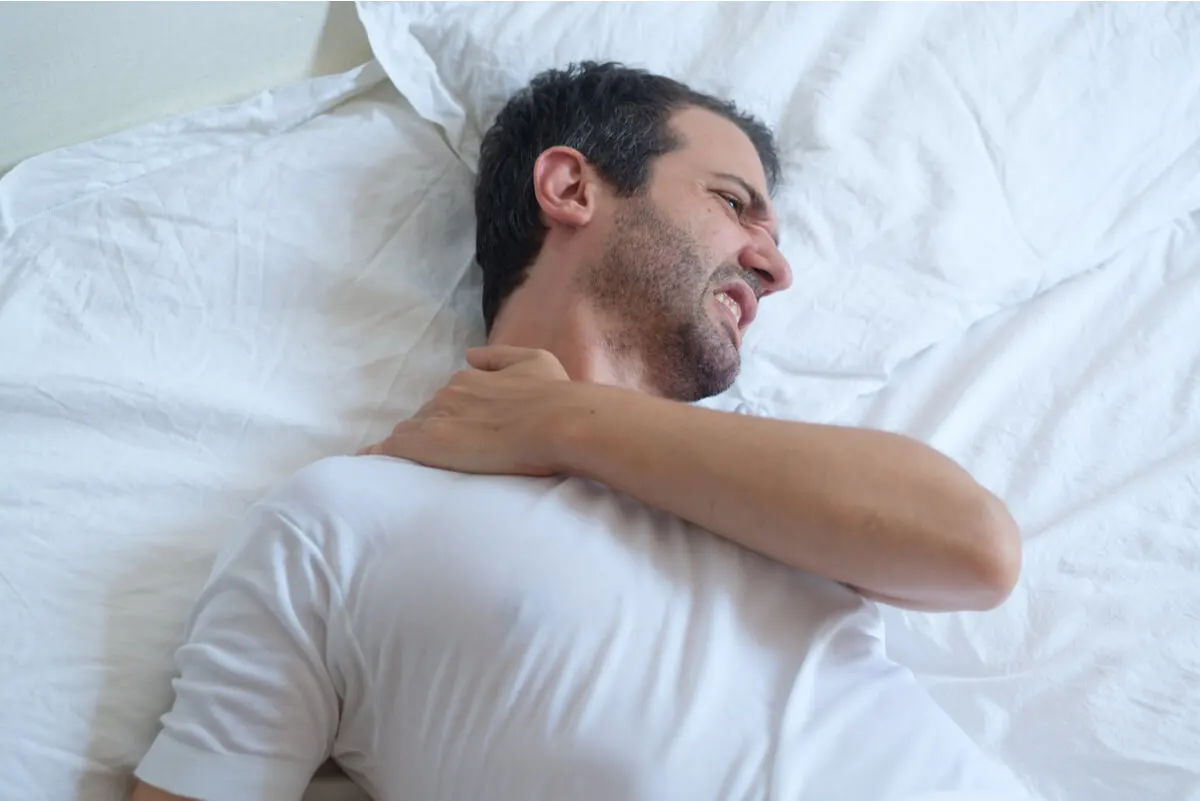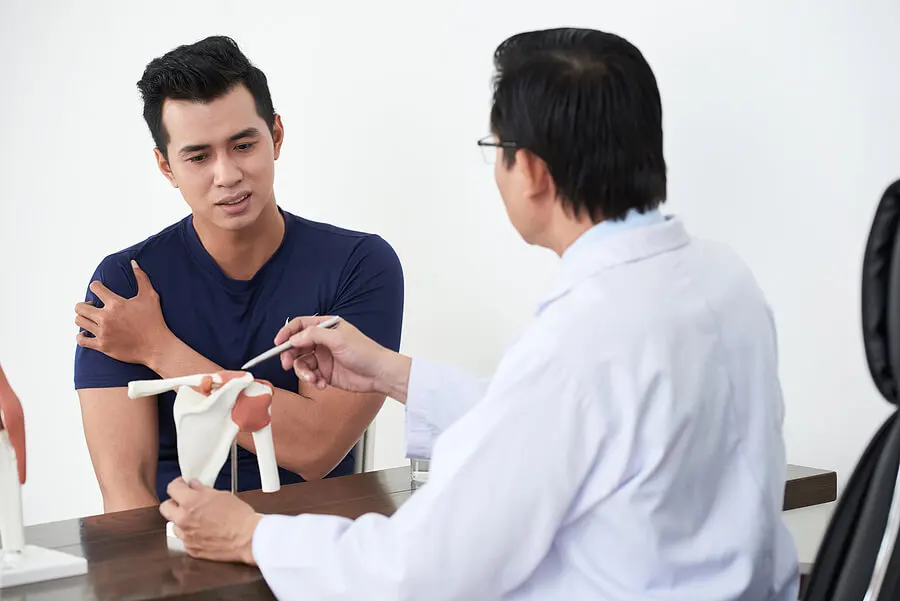Calcification of the Shoulder: Symptoms and Causes


Written and verified by the doctor Leonardo Biolatto
Calcification in the shoulder is also known as calcifying tendinitis of the shoulder. As its name indicates, it attacks this large joint that regulates the movement of the upper limb, so its affectation results in limitation of the opening angle of the arm.
It has been reported to occur more frequently among women over 40 years of age and, above all, on the side they use the most. That is to say, right-handed people have it on the right side and left-handed people on the left shoulder. There are also bilateral clinical presentations, although they’re less common.
Causes of calcification in the shoulder

This condition is caused by the accumulation of calcium in one of the most important tendons in human anatomy: the rotator cuff tendon of the supraspinatus muscle. This is a soft tissue with fundamental functions for the mobility of the shoulder.
The bursa of the acromion can also become calcified in the condition. Bursae are pockets of joint fluid that lubricate the joint between two bones. In this case, the one that’s affected is the one below the acromion bone.
The reality is that, at present, the precise origin of calcification in the shoulder is unclear. Once the mineral accumulation is detected, it’s difficult to pinpoint why it started in the first place. Above all, there’s confusion because it’s often diagnosed in people who don’t have a clear history of shoulder injuries.
The presence of osteoarthritis or arthritis focused on other joints is also not indicative or a risk factor. In the same way, hormonal alterations are not directly linked to the tendency to deposit calcium.
In this sense, for many specialists, we’re dealing with a typical shoulder disease – that is to say, specific to this joint and no other. A different case is that of a condition such as rheumatoid arthritis, which is more generalized and attacks the joint as part of the whole syndrome.
Scientific studies are also not conclusive regarding the relationship with sports. Although there are occasional records of people who suffer from calcification of the shoulder due to overuse, it’s not the rule. At the other extreme, neither can it be attributed to a sedentary lifestyle.
We think you may be interested in reading this, too: Tendonitis in the Shoulder: Symptoms, Causes, and Treatment
Symptoms of calcifying tendinitis of the shoulder

Pain in shoulder calcification is the primary sign. Its intensity depends on the evolutionary stage of the disorder, since at first, it’s no more than a passing discomfort while the calcium is being deposited. In the second stage, the attack is acute and disabling.
This doesn’t necessarily mean that the condition is worsening in terms of the amount of adherent mineral. On the contrary, in many cases, the increase in pain corresponds to the reabsorption of calcium that the body is resolving.
Larger accumulations are more bothersome, although they may not hurt as much. The problem with bulky sizes is that they disturb neighboring structures and ankylosing tissues. In ankylosing, cells and fibers that should be more flexible stiffen, and the joint becomes stiff.
This is the situation with adhesive capsulitis. This is a complication of calcification in the shoulder that limits the opening of the arm and leads to a loss of strength, making it difficult to hold objects in the hand or to raise the arm above the head to reach something.
The time of evolution is very variable. Even with treatment, each person responds differently and can go from months to years with the condition.
Like this article? You may also like to read: What is Kyphosis and Why Does it Occur? 6 Tips to Treat Kyphosis
Diagnosis and treatment

After consultation for shoulder pain, the next logical step is to request an X-ray of the joint to evaluate it. However, this complementary method isn’t usually decisive. It serves to rule out other processes, but it’s difficult for the accumulated calcium to be expressed as such.
In this part of the diagnostic process, soft tissue ultrasound and magnetic resonance imaging are used. In these cases, there are more possibilities to register signs of degeneration of the affected tendons. One of the classic signs is the shrinkage of the joint space in the shoulder, which denotes the increased contact between the bony tissues.
Upon certification of calcifying tendinitis, the orthopedic surgeon will indicate an approach that, in principle, is usually conservative. This is based on the prescription of anti-inflammatory drugs and the performance of physiotherapy sessions.
Within kinesiology, the validated approaches are diverse. Some professionals prefer to use manual maneuvers, while others prefer shock waves or temperature devices. In general, local cold is preferred.
The surgical approach is reserved for the most rebellious cases to conservative treatment. The most commonly used technique is trocar puncture, which consists of introducing a special needle into the shoulder to absorb the calcification.
When should I see a doctor?
If you experience pain in your shoulder that intensifies when you move it, it’s a good idea to see a doctor. This is especially the case if there’s an added limitation of arm movement when trying to grasp objects or when lifting the arm above your head.
Although many cases resolve on their own with the passage of time, it’s necessary to get a proper diagnosis through complementary methods. A simple ultrasound may be sufficient to determine the presence of shoulder calcification and treat it accordingly.
All cited sources were thoroughly reviewed by our team to ensure their quality, reliability, currency, and validity. The bibliography of this article was considered reliable and of academic or scientific accuracy.
- Pereira Quispeynga, Mario Luis. “Prevalencia de lesiones del manguito rotador en pacientes con hombro doloroso evaluados por ecografía en el Servicio de Radiología del Hospital Cayetano Heredia, octubre 2018-marzo 2019.” (2019).
- Miranda, I., et al. “Tendinitis calcificante de hombro con extensión intraósea: experiencia con el tratamiento artroscópico y revisión de la literatura.” Revista Española de Cirugía Ortopédica y Traumatología 64.1 (2020): 13-21.
- Ugalde Ovares, Carlos Eduardo, Daniel Zúñiga Monge, and Ricardo Barrantes Monge. “Actualización del síndrome de hombro doloroso: lesiones del manguito rotador.” Medicina legal de costa rica 30.1 (2013): 63-71.
- De la Rosa-Morillo, F., J. C. Galloza-Otero, and W. Micheo. “Rehabilitacion del hombro doloroso en el atleta joven.” Rehabilitación 53.2 (2019): 85-92.
- Galán, Cristina Narváez, et al. “Efectividad del lavado aspiración percutáneo ecodirigido como tratamiento de la tendinitis calcificante del hombro.” Seram (2018).
- Rodríguez, Javier José Mateos, et al. “Miositis del subescapular. Una evolución infrecuente en la tendinopatía calcificada. Estudio de un caso.” Revista Colombiana de Reumatología (2020).
- Serrano Ardila, Ana María, and Sergio Abush Torton. “Capsulitis adhesiva.” Anales Médicos de la Asociación Médica del Centro Médico ABC 62.1 (2017): 37-43.
- Gramajo Arriola, Erick Juan José, and Samuel Eduardo García Díaz. Diagnóstico del ultrasonido en el hombro doloroso. Diss. Universidad de San Carlos de Guatemala, 2016.
- Herrera, Elizabeth O’Relly, et al. “Ondas de choque en el tratamiento de tendinitis calcificada del supraespinoso en adulto mayor.” Revista Cubana de Medicina Física y Rehabilitación 8.2 (2017).
This text is provided for informational purposes only and does not replace consultation with a professional. If in doubt, consult your specialist.








